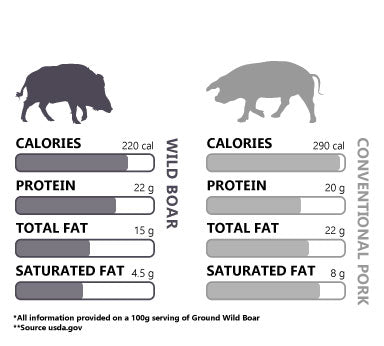
Wild Boar is an ancestor of the Suidae species, a hog that lived as far back as the Ice Age. During the Stone Age, early man frequently hunted these animals, however their population continued to thrive across Africa, Asia, and Europe. Wild Boar is not native to the United States, for their access to North America was limited due to the extreme cold temperatures and glacial landscape of the continent during the Ice Age.
Christopher Columbus brought Wild Boar to the Caribbean in 1493 and later, Spanish conquistadors and French explorers brought small populations of Wild Boar to the mainland of North America during their own funded expeditions to explore the New World.
Once the United States was established, early settlers moved West and relied on cured Wild Boar for a shelf stable food supply and used its lard for everyday cooking. Many of the free range, domestic hogs Texas settlers owned became feral when people abandoned their homesteads during times of economic hardship or war.
In the 1930s, Russian Razorback or Eurasian Wild Boars were brought to Texas and released for hunting. These hogs bred with the formerly free ranging, domestic hogs that turned feral and have since become identified as an invasive species because they are severely overpopulated, devastate native plants and wildlife within their own ecosystem, and cause millions of dollars in agricultural damage across 39 of the United States and four Canadian provinces.
On Sustainability:
When any animal is living its everyday life in the wild, it naturally contributes to the greater ecosystem it’s a part of. While the case with Bison is positive, to the extent that they help spread native seeds as the graze from place to place, Wild Boar’s contribution to the ecosystem tends to have a more negative impact because they are considered “ecosystem engineers.” That means, they can alter the flow of water runoff in wetlands which can severely impact the balance of the forest’s ecosystem, for plant and animal life. They also compete for resources amongst other mammals and are predators to many animals, young and mature alike.
This has caused many species, some of which were already considered to be threatened or endangered, from experiencing even more risk in their ecosystem, from plants, like milkweed, to a number of birds, mammals, and reptiles, including prairie chickens, wild turkeys, squirrels, bears, mongoose, sea turtles, toads and dragonflies.
Consuming Wild Boar therefore does not contribute to the greenhouse gases and other environmental impacts caused by factory farming, while also helping with population management of the species and perhaps someday, bring equilibrium back to ecosystems across the world, from the United States and Canada, to Europe, North Africa, India, and China.
On Nutrition:
Being foragers and hunters that are constantly on the move, Wild Boar are a great alternative to conventional pork because they contain a higher density of nutrients, including iron and zinc, and are more lean, translating to less calories, fat, and cholesterol per serving. 
Fossil Farms' Wild Boar:
Fossil Farms’ Texas Wild Boar is truly wild. Being that the animals are harvested directly in the environment in which they live, that inherently makes them free of antibiotics, steroids, and hormones. We also source Russian Razorback Wild Boar from Canada, where they are free to range and forage across a vast landscape of fields and forests. To supplement their diets through the Fall and Winter, when there is less plant life to consume, they are given vegetarian grains, sourced from local farms.
Although Wild Boar is considered a game meat, it leaves no trace of tasting gamey. Rather, it’s rich taste has sweet and nutty undertones, making for a flavorful bite!
Fun Facts:
> Groups of Wild Boar are called a sounder, which seems rather suiting because hogs communicate audibly with barks, grunts and squeaks. Males live a solitary lifestyle, unless during mating season, so sounders are only composed of females and piglets.
> Ancient Greeks and Romans hunted Wild Boar as a sport, most often amongst adult men or as a coming-of-age experience for young men.
> Some of the earliest artistic renderings of Wild Boar date back to the Late Stone Age.

Share:
Read up on Angus Beef
Craveable Impact